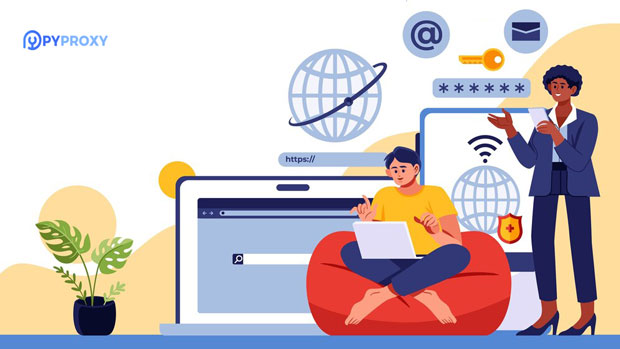In the digital age, privacy and anonymity have become vital concerns for internet users. One popular method to protect one’s privacy is the use of proxies, which mask a user’s real IP address. ProxySite is a commonly used proxy tool, but many people question whether using it exposes their real IP. In this article, we will deeply analyze the workings of ProxySite and explore the potential risks of exposing your real IP. Understanding these risks can help you decide whether ProxySite is a reliable choice for online privacy protection. Introduction to Proxy Services and ProxySiteProxy services are designed to act as intermediaries between the user and the websites they wish to visit. When using a proxy, the user’s IP address is masked, and the server of the proxy provider displays its own IP. This allows users to access websites without revealing their personal IP address. ProxySite, like many other proxies, offers the ability to route internet traffic through its servers, supposedly providing an extra layer of security and anonymity.While proxies can be effective in hiding the user’s identity, there are limitations and potential vulnerabilities. The question many users face is whether tools like ProxySite can still expose their real IP address, leaving them vulnerable to tracking.How Does ProxySite Work?To understand if ProxySite can expose your real IP, we must first examine how it works. When you visit a website through ProxySite, the request is sent to ProxySite’s server. The server then forwards the request to the website you intend to visit. The website will see the IP address of ProxySite’s server, not your personal IP address.This process creates the illusion of anonymity because the website doesn’t receive your real IP. However, there are several factors to consider that could compromise your anonymity.Can Your Real IP Be Exposed While Using ProxySite?Even though ProxySite is designed to hide your real IP address, there are still potential risks that could expose it. Some of these include:1. ProxyLeaks: This refers to instances where your real IP address is exposed through leaks in the proxy server or browser settings. For example, certain browsers and operating systems can send requests that bypass the proxy and expose your real IP. This issue is more common with free proxy services like ProxySite. 2. WebRTC Leaks: WebRTC (Web Real-Time Communication) is a protocol used for browser-based communication. Sometimes, WebRTC can leak your real IP address, even if you are using a proxy. This happens because WebRTC can create peer-to-peer connections that bypass the proxy.3. DNS Leaks: When using a proxy, DNS requests (which translate website names into IP addresses) may still be sent through your default DNS servers, potentially exposing your real IP address. Proxy services that do not protect against DNS leaks may be vulnerable.4. Misconfigured Proxy Settings: If you mistakenly configure your proxy settings or use a weak proxy, your real IP address could be exposed. ProxySite, like many free proxy tools, may not be as secure as premium services, potentially increasing the risk of exposure.What Are the Risks of Exposing Your Real IP?Exposing your real IP address can have serious privacy and security implications. Some of the risks include:1. Tracking and Surveillance: If your real IP is exposed, websites and advertisers may track your online activity. This could lead to the creation of detailed profiles about your browsing habits, potentially leading to intrusive targeted ads and data collection.2. Geolocation Risks: Your IP address reveals your approximate geographical location. If malicious actors obtain your real IP, they could determine your country or city of residence, leading to increased risks of physical and cyber attacks.3. Access Restrictions: Some websites or services may block access from certain IP addresses. If your real IP address is exposed, you might face restricted access or even be blacklisted from certain sites, particularly if you attempt to bypass geographical restrictions using proxies.4. Data Theft: Exposing your real IP could make you more vulnerable to cyberattacks, including DDoS (Distributed Denial of Service) attacks. Hackers can target your IP address to overwhelm your connection or attempt to steal personal data.How to Protect Your IP When Using ProxySiteTo minimize the risk of exposing your real IP while using ProxySite, there are several strategies you can employ:1. Use a VPN in Addition to ProxySite: A Virtual Private Network (VPN) provides an additional layer of encryption and IP masking. When used alongside ProxySite, a VPN can ensure that your real IP address is hidden, even if the proxy fails.2. Disable WebRTC: You can disable WebRTC in your browser settings to prevent leaks of your real IP. Many browsers allow users to turn off WebRTC, reducing the chances of exposing your IP while using a proxy.3. Use a Secure DNS Service: Using a trusted DNS service that supports DNS leak protection will help ensure that your DNS queries are routed through the proxy server, preventing leaks of your real IP.4. Test for IP Leaks: Regularly test your connection for potential IP leaks while using ProxySite. There are various online tools that can detect if your real IP address is being exposed during proxy usage. 5. Consider Using a Premium Proxy Service: While ProxySite is free and convenient, it may not offer the highest level of security. Premium proxy services often provide additional features like better encryption, more reliable connections, and better leak protection.Conclusion: Is ProxySite Safe for Anonymity?In conclusion, using ProxySite can provide a certain level of anonymity by masking your real IP address, but it is not without risks. Issues such as proxy leaks, WebRTC leaks, DNS leaks, and misconfigurations can potentially expose your real IP. If privacy is a critical concern for you, it is advisable to take extra precautions, such as using a VPN in combination with ProxySite, disabling WebRTC, and regularly testing for IP leaks.Ultimately, while ProxySite can help mask your IP in many situations, it is important to understand its limitations. If you require a higher level of security, you may want to consider investing in a more robust, premium proxy service. By being aware of the potential risks and taking necessary precautions, you can use ProxySite more safely and protect your online privacy.
Jul 10, 2025
![arrow]()



















































